Executive Summary
The Monetary Policy Committee (MPC) of the Bank of England (BoE) recently hiked its main policy rate for the first time in more than 10 years. The U.K. economy has not weakened as much as the MPC had feared last year in the immediate aftermath of the Brexit referendum, so the rate hike simply takes back the "insurance" easing that the central bank undertook in August 2016. So is the MPC’s rate hike a once-and-done affair, or does more tightening lie ahead?
We look for the CPI inflation rate in the United Kingdom to slowly recede toward the two percent inflation target in the quarters ahead as the price-lifting effects of sterling depreciation fade. If, as we expect, the economy continues to grow, then we believe that the MPC will feel confident enough to raise rates again next summer. That said, we certainly acknowledge the downside risks to our forecast that emanate from Brexit uncertainty. If these uncertainties cause businesses to retrench via lower investment and/or cuts to payrolls, the British economy could weaken further. In that event, prospects for further monetary tightening in the United Kingdom would fade.
CPI Inflation Has Overshot the Central Bank’s Target This Year
In a recent report we discussed the outlook for Eurozone CPI inflation that was derived from our proprietary models and the implications of those forecasts for ECB monetary policy going forward.1 We follow a similar methodology in this report for the United Kingdom. Namely, we discuss two forecasting models of British CPI inflation, and then use the forecasts that are generated by those models to inform our views about U.K. monetary policy going forward.
Starting in 1997, when the BoE gained operational independence, the British government gave the central bank an inflation target of 2 percent over the medium term. The BoE has generally been successful in fulfilling its mandate, although there have been periods over the past 20 years in which the BoE has either overshot or undershot its inflation target. For example, CPI inflation significantly undershot the BoE’s target throughout 2015 and 2016, but it has consistently been above target most of this year (Figure 1).
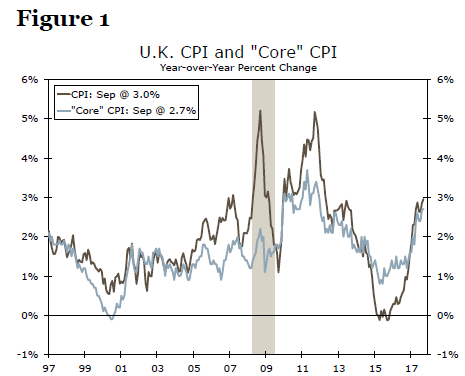
The stabilization in energy prices that has occurred during the past year or so helped to lift the overall CPI inflation rate back toward the core rate of inflation, which excludes energy and other goods with volatile prices. That said, the core inflation rate has also risen markedly this year, which has helped to pull the overall rate of inflation even higher. Much of this increase in the core inflation rate reflects the significant decline in the trade-weighted value of the British pound in the immediate aftermath of the Brexit referendum in June 2016 (Figure 2). The sharp depreciation of sterling lifted import prices, which subsequently imparted upward momentum to CPI inflation.
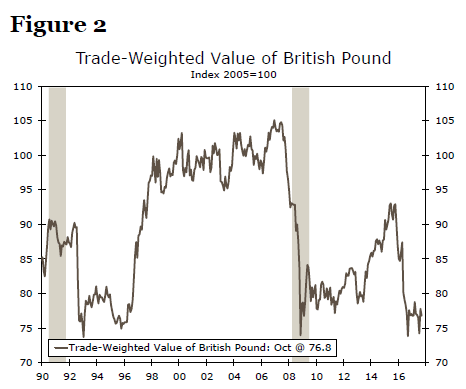
Despite the above-target rate of inflation in 2017, the MPC refrained from tightening monetary policy for much of the year due to the uncertainties that Brexit imparted to the British economy. Indeed, in the immediate aftermath of the Brexit referendum last year the MPC reduced its main policy rate by 25 bps (Figure 3) and it increased the size of its government bond purchase program from £375 billion to £435 billion (Figure 4). The MPC reasoned that economic weakness associated with Brexit uncertainty could eventually cause CPI inflation to undershoot its target. However, real GDP growth has not slowed as much as the BoE had feared at the time of the Brexit referendum, so the MPC recently took back its rate cut. But the BoE continues to maintain its £435 billion stock of government bond purchases.
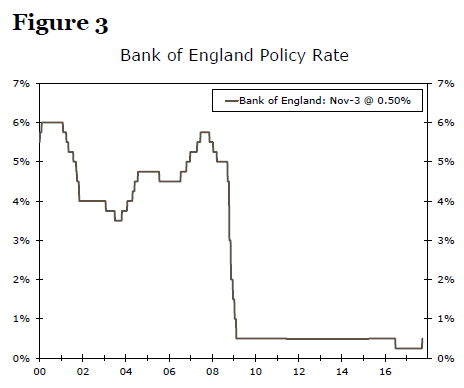
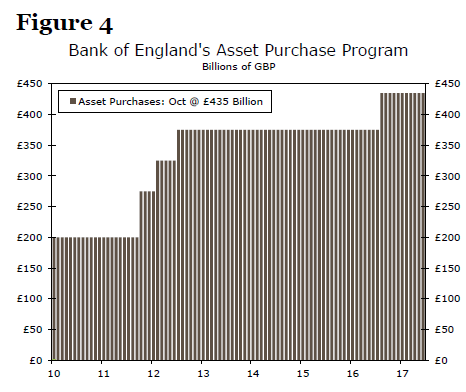
Will Inflation Recede Back Toward Target?
With the economy continuing to expand, albeit at a slow pace (real GDP was up only 1.5 percent on a year-ago basis in Q3-2017), and with CPI inflation a full percentage point above target, will the MPC hike rates further in coming months? To shed some light on this question, we used a model similar to the one that we employed in our analysis of Eurozone inflation dynamics that was noted previously. Specifically, we model CPI inflation in the United Kingdom to be a function of the output gap (i.e. the difference between actual GDP and potential GDP as a percent of the latter), long-run inflation expectations, and the sterling-denominated price of Brent oil. We then use our forecasts of these independent variables to generate a forecast of U.K. CPI inflation through the end of 2019. The results are shown in Figure 5.
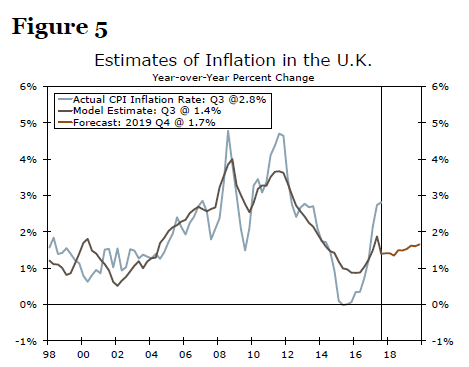
As in the case of our Eurozone analysis, our model does a reasonable job of capturing the inflation dynamics in the United Kingdom, although it tends to under-predict sizeable swings that sometimes can arise. Indeed, the model is currently under-predicting the actual CPI inflation rate by nearly 1.5 percentage points. This large error probably reflects the sharp depreciation of sterling over the past year which is not captured by our model.
The actual inflation rate and the model-generated inflation rate have tended to eventually converge when large errors have occurred in the past, and we look for the difference to narrow in the months ahead. Specifically, we look for the actual CPI inflation rate to recede as the one-off effects of sterling depreciation on the price level run their course. But our model-generated forecast of inflation drifts higher in coming months, so the actual rate of inflation likely will not fall all the way back to the current model prediction (1.4 percent).
This assessment is consistent with our probit model, which suggests that the probability of "deflationary pressure" (i.e., a CPI inflation rate less than 1.5 percent within six months) is falling while the probability of "stable prices" (i.e., CPI inflation between 1.5 percent and 2.5 percent within six months) is rising (Figure 6). Our actual forecast looks for CPI inflation in the United Kingdom to recede from its current rate of 3 percent back to 2 percent by mid-2019. Our CPI inflation forecast is in line with both the consensus forecast and with the inflation outlook of the BoE.
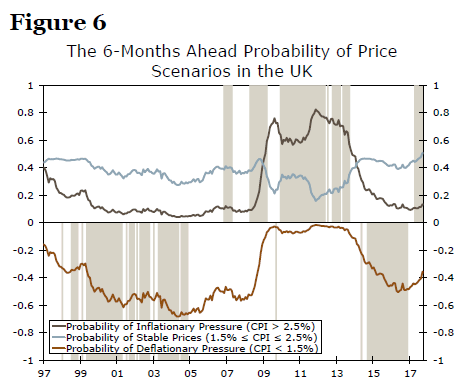
How Quickly Will the MPC Tighten Policy?
As noted above, the MPC decided at its last policy meeting on November 2 to raise it main policy rate by 25 bps. In the statement that announced the rate hike, however, the MPC did not seem to be in a hurry to tighten further, saying that any future rate hikes "would be expected to be at a gradual pace and to a limited extent." Furthermore, the statement highlighted the downside risks to the economic outlook posed by the uncertainty of the Brexit process.
We expect that the MPC will maintain this wait-and-see approach for the next few months. In our view, the MPC will refrain from hiking rates again until the third quarter of 2018. This view is predicated on our assumption that Brexit uncertainty does not derail the economic expansion. If, as we expect, inflation recedes in coming months now that sterling has stabilized, then growth in real consumer spending should pick up as real income growth recovers. Stronger GDP growth should eventually give enough comfort to a majority of MPC members to hike rates again.
That said, we acknowledge the downside risks to our forecast that emanate from Brexit uncertainty. A "soft" Brexit would make only minor changes to the economic and financial relationship that the United Kingdom has with the other 27 members of the European Union (EU-27). On the other hand, a "hard" Brexit could potentially entail an entire reorganization of that relationship. At this point, negotiations between the United Kingdom and the EU-27 are underway, but nobody really knows now what the ultimate relationship will eventually be. This uncertainty about the U.K.’s future relationship with its most important trading partners – about one-half of British exports go to the EU-27 – could eventually weigh on investment and hiring decisions in the United Kingdom.
In that regard, investment spending and payrolls in the United Kingdom both continue to grow. However, a measure of investment "intentions," which has a fair degree of correlation with growth in actual investment spending, remains fragile (Figure 7). Employment continues to grow, but it has decelerated over the past year or so (Figure 8). If Brexit uncertainty causes businesses to retrench via reduced investment spending and cuts to payrolls in coming months, the MPC surely would shelve any intentions to hike rates next year.
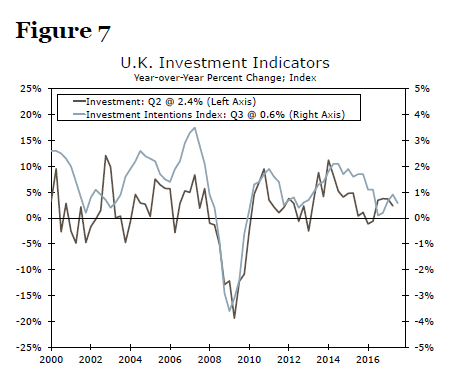
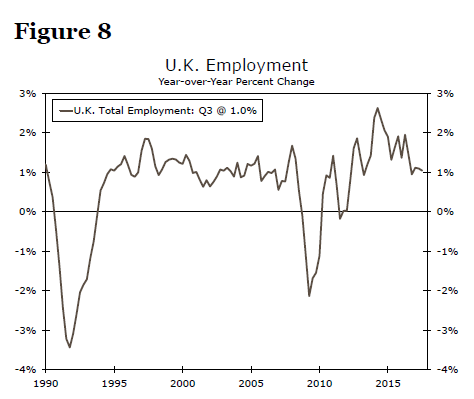
Conclusion
The value of the British pound weakened significantly in the immediate aftermath of last year’s Brexit referendum, which then caused the CPI inflation rate to shoot above the BoE’s target of two percent. Rather than tighten policy, however, the MPC decided in August 2016 to cut its main policy rate by 25 bps. The MPC reasoned that economic weakness, which it expected in the quarters after the Brexit referendum, could eventually cause the CPI inflation rate to undershoot the two percent target. But the economy has not weakened as much as the MPC had feared, so it recently took back that rate cut.
We look for the CPI inflation rate in the United Kingdom to slowly recede back toward the two percent inflation target in the quarters ahead as the price-lifting effects of sterling depreciation fade. If, as we expect, the economy continues to grow, then we believe that the MPC will feel confident enough to raise rates again next summer. Looking further ahead, we forecast two 25 bps rate hikes in 2019.
That said, the U.K. economic outlook is held hostage, at least in part, to uncertainties associated with the Brexit negotiation process. Unfortunately, it is essentially impossible to accurately predict the outcome of that process at this time. But if these uncertainties cause businesses to retrench via lower investment and/or cuts to payrolls, the British economy could weaken further. In that event, prospects for further monetary tightening in the United Kingdom would fade. Stay tuned.















